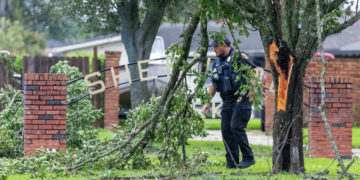Tina Christopher and her mother spent the night at their darkened home in Morgan City, La., listening to hurricane-force winds howl and branches pelt the roof. ”I’ll never stay for a storm again,” Ms. Christopher, 57, said after emerging on Thursday morning.
Hurricane Francine made landfall on the swampy coastline near their home late Wednesday as a Category 2 hurricane with 100 mile-per-hour winds. The storm, which quickly weakened over land, damaged buildings and caused flooding and power outages in New Orleans and the small cities and towns to its southwest.
Fishing is among the major industries in the region, where residents have been battered, and hardened, by natural disasters in recent years. Officials said the area appeared to have made it through Francine without significant damage.
“We have no reports of storm-related fatalities,” Gov. Jeff Landry of Louisiana said at a news conference, “and we want to keep it that way.”
In New Orleans, floodwaters inundated low-lying streets and suburban homes overnight but were clearing up by Thursday afternoon. Drainage systems, which local officials said had been overwhelmed at times, furiously pumped out rainwater. Some residents were asked conserve water to avoid overloading the sewers.
In the town of Thibodaux, not far from Morgan City, more than two dozen people had to be evacuated overnight, officials said, including many from a public housing complex where rising water cut off vehicle access. They were driven to a shelter in high-water emergency vehicles.
“Our biggest challenge right now is the restoration of energy,” said Sheriff Craig Webre of Lafourche Parish, where Thibodaux is. Forty utility poles needed maintenance, he said, leaving about 80 percent of the parish without power on Thursday afternoon.
A Lowe’s hardware store in Thibodaux appeared to be the most happening spot in town. It had power thanks to a generator, and the manager, Tiara Brown, 35, said customers were buying plywood, batteries, air movers, flashlights, dehumidifiers and, of course, their own generators.
In St. James Parish, about 50 miles west of New Orleans, about 90 percent of residents were without power, and a hospital was running on generators, according to the parish president, Pete Dufresne. Water levels were receding slowly, but a portion of Highway 20, a main artery, was impassable at midday.
Officials warned residents to stay off the roads and to be careful around downed power lines.
Most of the buildings in Houma, about 55 miles southwest of New Orleans, made it through the storm intact, but one structure, a thrift shop called Junk in the Trunk, was partially destroyed, as if the storm had reached down to peel away only its roof and no others.
The top of the building was a mangled heap of curled metal, letting sunlight in where the ceiling used to be.
The owner of the shop, Dan Stevens, said he had rushed to the shop on Wednesday evening after friends told him about the damage. “It’s just one of those things,” he said as he surveyed the damage, trying to decide whether to repair the building or tear it down.
As floodwaters receded and sunlight began to peek through clouds on Thursday, residents in this corner of Louisiana showed how familiar they have become with powerful storms blasting through their neighborhoods.
In Berwick, a town of about 4,600, an Exxon convenience store was still open and taking cash while the power was out. The owner, Mary Myers, was giving out all the ice cream left in her freezer.
“I’ve had this location for 30 years, and today we’re just helping take care of the community,” Ms. Myers said.
Ms. Christopher, after her harrowing night at home in Morgan City, said that the water had come all the way up to her back porch before receding. The wind, she said, sounded like lions roaring.
By morning, a tree that used to shade their front yard was stripped of many of its leaves and branches, which littered the lawn. A generator was running by the front door. It was unclear when the power would return.
The post Residents Survive a Harrowing Night as Francine Blasts Louisiana appeared first on New York Times.



















